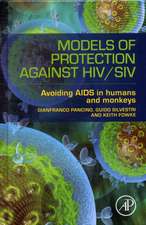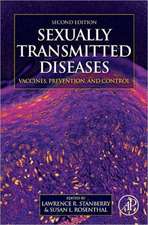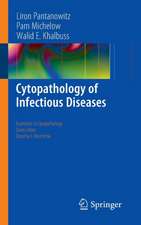HIV, Resurgent Infections and Population Change in Africa: International Studies in Population, cartea 6
Editat de Michel Caraël, Judith Glynnen Limba Engleză Paperback – 12 aug 2008
Understanding the population impact and the dynamics of infection diseases in the most affected region is critical to efforts to reduce the morbidity and mortality of such infections, and for decisions on where to use limited resources in the fight against infections.
This book aims to contribute to these efforts by offering a demographic and epidemiological perspective on emerging and reemerging infections in sub-Saharan Africa.
| Toate formatele și edițiile | Preț | Express |
|---|---|---|
| Paperback (1) | 715.00 lei 6-8 săpt. | |
| SPRINGER NETHERLANDS – 12 aug 2008 | 715.00 lei 6-8 săpt. | |
| Hardback (1) | 722.12 lei 6-8 săpt. | |
| SPRINGER NETHERLANDS – 25 oct 2007 | 722.12 lei 6-8 săpt. |
Preț: 715.00 lei
Preț vechi: 752.63 lei
-5% Nou
Puncte Express: 1073
Preț estimativ în valută:
136.83€ • 142.33$ • 112.96£
136.83€ • 142.33$ • 112.96£
Carte tipărită la comandă
Livrare economică 14-28 aprilie
Preluare comenzi: 021 569.72.76
Specificații
ISBN-13: 9781402061738
ISBN-10: 1402061730
Pagini: 268
Ilustrații: XII, 268 p.
Dimensiuni: 155 x 235 x 15 mm
Greutate: 0.4 kg
Ediția:2007
Editura: SPRINGER NETHERLANDS
Colecția Springer
Seria International Studies in Population
Locul publicării:Dordrecht, Netherlands
ISBN-10: 1402061730
Pagini: 268
Ilustrații: XII, 268 p.
Dimensiuni: 155 x 235 x 15 mm
Greutate: 0.4 kg
Ediția:2007
Editura: SPRINGER NETHERLANDS
Colecția Springer
Seria International Studies in Population
Locul publicării:Dordrecht, Netherlands
Public țintă
ResearchCuprins
Trends and Diseases.- World Mortality 1950–2000: Divergence Replaces Convergence from the Late 1980s.- The Impact of Population Growth on the Epidemiology and Evolution of Infectious Diseases.- Why Child Mortality in Sub-Saharan Africa has Ceased Declining since the Early 1990s. The Example of Senegal, a Country where the Hiv Epidemic has Remained at a Low Level.- Malaria, Climate Change and Possible Impacts on Populations in Africa.- Economic Crisis and Changes in Mortality Due to Infectious and Parasitic Diseases in Antananarivo, Madagascar.- Economic and Ethical Aspects of Controlling Infectious Diseases.- HIV and its Impact.- HIV Infection in Young Adults in Africa: Context, Risks, and Opportunities for Prevention.- Sexual Behaviour Change, Marriage and HIV Prevalence in Zambia.- Migration, HIV/AIDS Knowledge, Perception of Risk and Condom Use in the Senegal River Valley.- HIV in Zimbabwe 1985–2003: Measurement, Trends and Impact.- The Impact of HIV Infection on Tuberculosis in Africa.- Impact of HIV on Mortality in Southern Africa: Evidence from Demographic Surveillance.- The Economic Impact of HIV/AIDS in Developing Countries: An End to Systematic Under-estimation.
Recenzii
"Provides a useful series of papers that introduce some key theoretical concepts relevant to demography, infectious disease modeling, and health economics together with some compelling case studies".
Studies in Family Planning, Volume 41, Number 3 (September 2010)
Studies in Family Planning, Volume 41, Number 3 (September 2010)
Textul de pe ultima copertă
Forty years ago, the age-old battle against infectious diseases as a major threat to human health was believed close to being won. However, by the late twentieth century, the increase of emerging and reemerging infectious diseases was evident in both low and high income countries. About 30 new infectious diseases have been identified in the last 20 years. Among the "new" diseases, and most importantly, the Human Immunodeficiency Virus (HIV) epidemic, with 40 million persons infected and 25 million deaths since its first description, presents one of the most significant health, societal and security challenges facing the global community. The interaction of HIV/AIDS with tuberculosis, malaria and bacterial infections have increased HIV-related morbidity and mortality, and in turn, the HIV pandemic has brought about devastating increases in tuberculosis.
Understanding the population impact and the dynamics of infection diseases in the most affected region is critical to efforts to reduce the morbidity and mortality of such infections, and for decisions on where to use limited resources in the fight against infections.
This book aims to contribute to these efforts by offering a demographic and epidemiological perspective on emerging and reemerging infections in sub-Saharan Africa.
Understanding the population impact and the dynamics of infection diseases in the most affected region is critical to efforts to reduce the morbidity and mortality of such infections, and for decisions on where to use limited resources in the fight against infections.
This book aims to contribute to these efforts by offering a demographic and epidemiological perspective on emerging and reemerging infections in sub-Saharan Africa.
Caracteristici
New highlights on the current burden of infectious diseases and on major trends in infectious mortality, as well as on the major determinants of infectious disease spread, such as mobility and urbanization, governance, health care systems, poverty and social exclusion. Contribute to a better understanding of the reasons why sub-Saharan Africa is lagging so much behind the other regions of the world in terms of global mortality decline.




















